The Stephen Petronio Company premieres a new work and revives one by Trisha Brown.
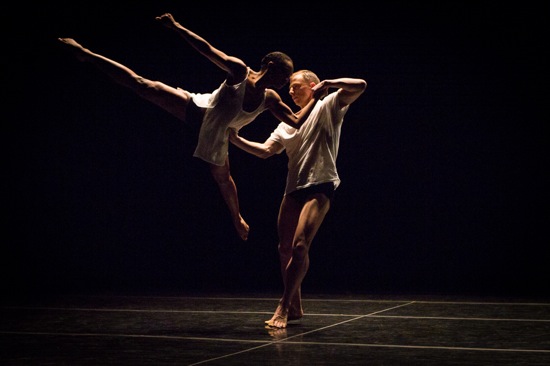
Davalois Fearon and Nicholas Sciscione in Stephen Petronio’s new Big Daddy (Deluxe). Photo: Yi-Chun Wu
Stephen Petronio’s five-year project, Bloodlines, pays homage to his heritage in the most loving and laborious of ways. He introduced it last year by having his dancers learn and perform Merce Cunningham’s great 1968 RainForest. This year, for the company’s season at the Joyce Theater, they tackled a work by a choreographer closer to Petronio’s generation: Trisha Brown’s Glacial Decoy (1979). Petronio joined her company—the first man to do so—the same year that marvelous dance was being made, and he stayed with her for seven years. Cunningham’s revolutionary ideas about space, time, and dance plus Brown’s surprising choices and extraordinary approach to movement nourished Petronio’s own style without defining it. Speaking to Chicago Tribune writer Laura Molzann about his choreography in relation to Brown’s, “My work is more punctuated rhythmically, both with stillness and with tension. Trisha—as you’ll see with ‘Glacial Decoy’—is more like smoke. And mine is like hot steel.”
Glacial Decoy, Brown’s first work for a proscenium stage, was true both to her bent for dealing with architectural realities and her impish wit. Choreographed for four women (with the possibility of a split-second surprise visit by a fifth), the piece first makes you think about the difference between onstage and offstage, with the initial two dancers appearing, one at a time, from the wings and disappearing back into them. Then two other dancers perform close together in the center of the stage for most of the next part. The final section introduces the coming together of all four, performing the same long spate of dancing and separated enough that (because the movement travels from side to side) one of them will disappear into the wings and only re-emerge when the others travel far enough in the opposite direction to bring her into sight and shunt a colleague temporarily offstage. Glacial Decoy is not just a dance that plays with the traditions of the proscenium stage; it’s a dance that becomes wider than the stage on which it’s being presented.
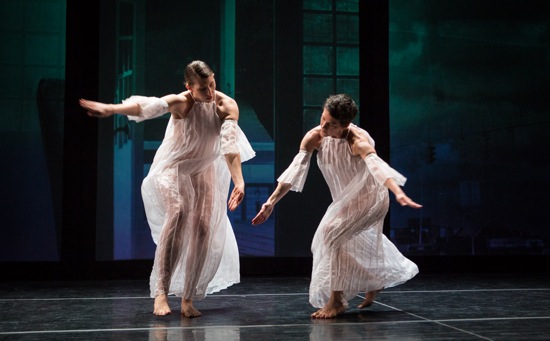
Emily Stone (L) and Cori Kresge in Trisha Brown’s Glacial Decoy. Photo: Yi-Chun Wu
Robert Rauschenberg designed the costumes and the set, and they’re in striking contrast to each other. His huge black-and-white photos travel across behind the dance. Images feed from stage right into four side-by-side “positions,” so that each image is seen four times before it “disappears” stage left. These beautifully composed pictures of shabby, everyday life (but without people) were taken in the Florida keys, I believe. The camera examines tilted bike handlebars, laundry on a line, a mailbox by the side of the road, the head of a marble statue shot from above, a truck, a doorway, and the like. Objects rust, vines grow around them.
Dancing in front of this long train of sights and gorgeously lit by Beverly Emmons, the performers appear as alien as butterflies. Rauschenberg’s costumes are translucent, pleated white bells that hang from just below their necks; smaller bells form the slip-on sleeves. Wearing these, the women conspire against the hard edges of the subjects in the photographs; because of the complicated fluidity of the dancing, the fabric is always in motion. (For some reason, the costumes don’t look quite as full as I recall the originals being, and as photos show them.)
Oh, that dancing! It’s as wild as that in Petronio’s choreography, but gentler, more peaceful. It plays games with itself. Movements large and small appear simultaneously on the performers’ bodies within a span of seconds. Like smoke, indeed. Head, arms, legs, hips, shoulders—they all seem to have minds of their own, but have decided to get along. A springy step is less about going into the air than an upbeat to a soft descent. The dancers gallop without emphasis, loose-limbed and quietly free.
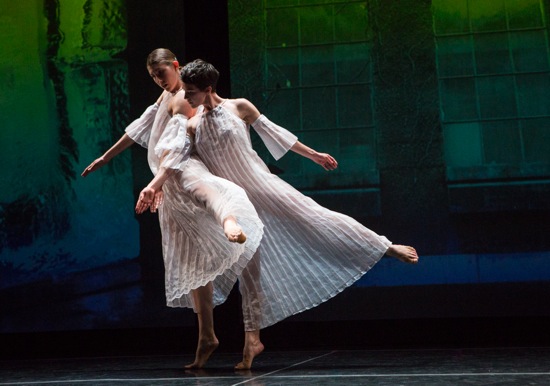
Emily Stone (L) and Cori Kresge in a rare moment of contact in Trisha Brown’s Glacial Decoy. Photo: Yi-Chun Wu
It must have been difficult (and perhaps enlightening) for Petronio’s dancers to come down from his slash-and-burn approach to complexity, even with the astute coaching of Diane Madden (co-artistic director of the Trisha Brown Dance Company) and Lisa Kraus from the original cast. Talking to Siobhan Burke of the New York Times, Petronio dancer Emily Stone recalls Kraus saying of a movement, “Do it and get off it.” In other words, the next move should be forming as the first fades away. That may be what occasionally bothers me a little about Jaqlin Medlock’s first appearance onstage. When she swings a leg into the air, she hints at a hair’s-breadth finish to the move before letting that leg respond to gravity. I watch her and Tess Montoya with admiration but want to shake them gently to make their heads and shoulders relax a bit more. Stone and Cori Kresge are more at home in looseness. In any case, I love entering Brown’s mind and body as I watch all four shiver and roll and smack the dancing around—rarely touching, occasionally sliding into unison as if this were an unexpected event. And how typical of the choreographer that she could put a fifth dancer (Davalois Fearon) into a costume and bring her—just once!— dancing on from stage right and soon cantering back where she came from. It’s as if Brown were saying, “Don’t get hooked on four women; this dance spans even more space than you thought it did.”
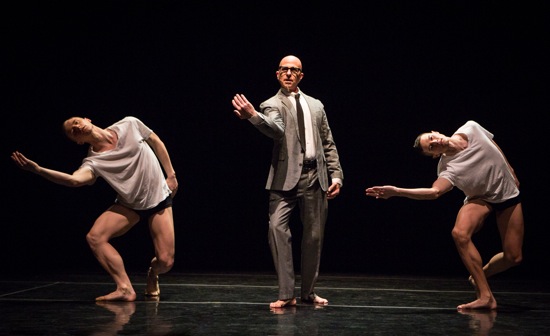
Stephen Petronio, flanked by Nicholas Sciscione (L) and Joshua Tuason in Petronio’s Big Daddy (Deluxe). Photo: Yi-Chun Wu
Somewhere, I think, Petronio used the word “familial” about this Joyce program, which includes the world premiere of his Big Daddy (Deluxe) and a revival of his 1990 MiddleSexGorge. The new work focuses on Petronio’s own family of Italian descent—with what seem like umpteen cousins, aunts, uncles, etc. etc. on hand to celebrate with enthusiasm any holiday occasion. For this, Petronio draws text from his own remarkable memoir, Confessions of a Motion Addict, and speaks it from the stage. The original Big Daddy (commissioned in 2014 by the American Dance festival) was a solo. The “deluxe” edition features his company as remembered visions, personae, and the forces that drive a life.
When the curtain goes up, Petronio in a suit and tie (but barefoot) advances into a pool of light. And then—a clever touch—Joshua Tuason and Nicholas Sciscione appear from behind him and fan out to either side, the three of them gesturing briefly in unison. Son Lux’s score, with its intermittently buried voice, breaks out: “This is. This is the. . .” This is the story, says Petronio, moving to a lectern at the side of the stage, “of my father.” He plans to build it “one word at a time.” Ken Tabachnick’s lighting brightens as the choreographer describes Petronio senior, with his movie-star aura—a man who enjoyed cooking, a man who loved to ballroom dance with his wife and did it well (“I had to wonder, when did they rehearse?” muses Stephen, their younger son).
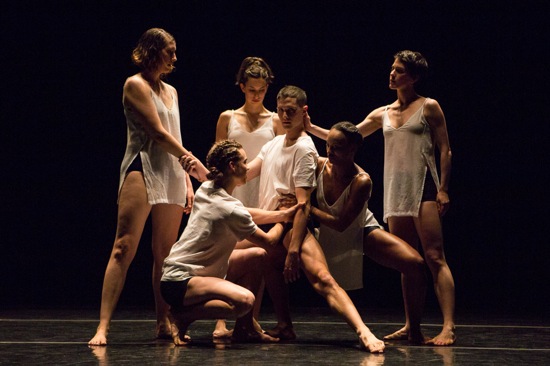
Stephen Petronio’s Big Daddy (Deluxe). Joshua Tuason surrounded by (L to R): Emily Stone, Kyle Filley (kneeling), Jaqlin Medlock, Davalois Fearon and Cori Kresge. Photo: Yi-Chun Wu
The dancers rush onto the stage and create pictures that we can’t always—don’t need to—interpret. No point wondering if one trio (Stone, Kresge, or Sciscione) or another later one (Montoya, Sciscione, and Fearon) represents some aspect of family games. But you can certainly imagine the four women and Kyle Filley who cluster to support Tuason as mothering a son or fawning over a handsome patriarch. Anyway, the dancing doesn’t strive to illustrate the words; instead it implies the changeable energy of the lives that gave Petronio his beginnings.
The text moves through two key moments—the father’s belated, carefully thought-through, ultimately generous response to Petronio’s marriage to another man and his last moments in the hospital, when his second son, Stephen, made the decision for the palliative care that would ease his transition into death. Petronio sits on the edge of the Joyce’s stage, telling us this. A few hours later, “He’s gone, that’s final.” It is and it isn’t. The father is as much in his son’s bones as Trisha Brown’s choreography, and that son is not embarrassed to let us know it.
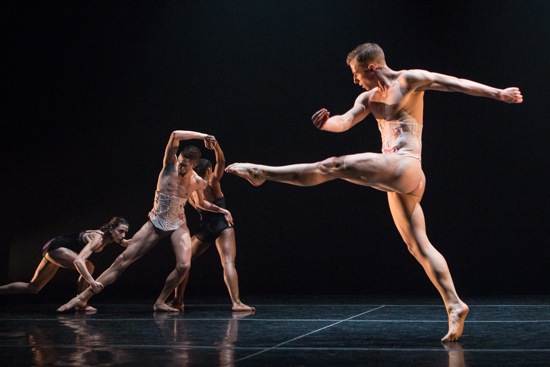
Stephen Petronio’s MiddleSexGorge. Peter Sciscione (R front) and (L to R): Jaqlin Medlock, Joshua Tuason, and Davalois Fearon. Photo: Yi-Chun Wu
MiddleSex Gorge is tied to the violent aspect of Petronio’s movement style. It was kindled by the AIDs epidemic of the 1980s, when he participated in demonstrations by ACT UP (the AIDs’ Coalition to Unleash Power). Here’s what he says in a program note: “The anger forged into my language is utilized as a call to action.”
He did indeed make an angry dance, also an erotic one, but neither of these qualities is depicted literally. The score by the British rock group Wire (their “Ambitious Plus,” remixed and lengthened by Paul Kendal and Wire) pounds out its beat while instruments wail and squeal above it , and voices roar from the terrific stew of sound and sink back into it: “When it’s hot I feel ambitious/ Fit for a princess/ Hot on the heels of an angel” And over and over: “Are you hot? Are you hot?/ Are you hot? Are you hot?” Yes, they are. The men wear lace-up corsets over jockstraps, and the women are clad in subtly lacy black under-leotards (costumes by H. Petal). The two who begin the dance (Fearon and Montoya, as I recall), grab their crotches, pump their ribs, push their hips out. Even when dancers plant themselves briefly, feet wide apart, knees bent, the beat keeps pounding—as if inviting them to get going again.
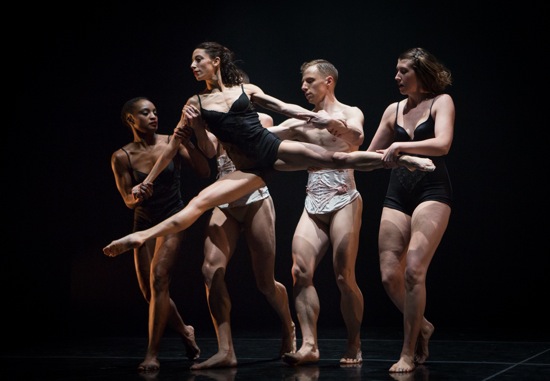
Jaqlin Medlock lifted by (L to R): Davalois Fearon, unidentified, Nicholas Sciscione, and Emily Stone in MiddleSexGorge. Photo: Yi-Chun Wu
But the dancing is more complex than the above would imply. The solo performed by Gino Grenek, wearing cut-off pants wreathed in artificial flowers below his corset, creates such fluent arguments with parts of his body that you can’t imagine how he keeps track of them. When people race onto the stage in groups and grab one another, the verb “yank” keeps coming to mind. No one just holds someone else’s hand or leg or lifts another person into the air. Every grasp expects a struggle; no one ever relaxes, no one ever looks comfortable. Watching the tableaux that congeal from time to time, you can’t be sure whether people are dragging one another down or helping one another up, or both simultaneously. Which is sort of what being in the middle of an epidemic is like. Or protesting publicly and being knocked down.
The superb dancers are individual within the language that Petronio has developed. As always, his choreography lets us get a good look at each of them: Sciscione or Fearon, suddenly alone onstage; Stone and Filley grappling together, while Matlock dances by herself; Montoya; Kresge; Grenek and Tuason, side by side, both in those flowered pants (channeling Petronio and Michael Clark in the 1990 version)—their costumes an ironic combination of restraint and gaudy, burgeoning growth.
Empowering and weakening, restraining and freeing, living and dying. . . .who says a dance can’t be about all that, and still be triumphantly beautiful?

Quite loved your embrace of the Trisha Brown work and your unique ability to make the dance move through your language. Especially liked the comments about Brown’s wildness also containing gentleness and peacefulness, and the need to do a bit of gentle shaking of a couple of dancers (a view I also shared seeing the same performance). I was swept away by the continuum of energy that Brown’s clever staging made you feel extended into the spaces of the beyond and the imagination. (At a March 12 Lisa Kraus and Eva Karczag talk/presentation on Brown in Philadelphia at Temple University,, Karczag remembered the piece as “endless.”)
But a bit too kind on the Petronio Big Daddy work, where the lectern reading from his memoir was for me too ponderous and drowning in sentiment.. Memoirs, especially, and more especially when literally staged, need editors and editing which was painfully wanting here. (I was even imagining a voice over as an alternative.)